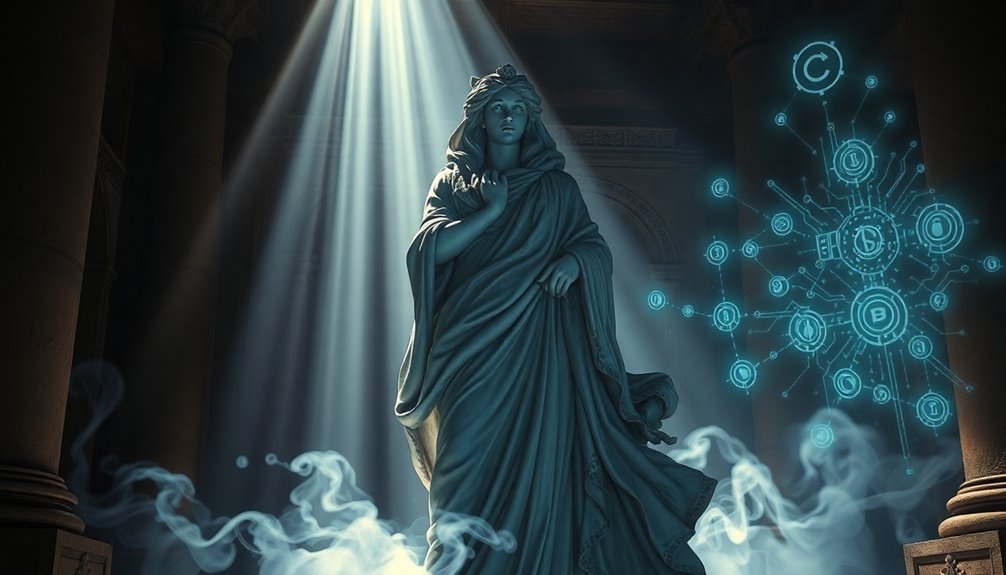Sibyls are ancient Greek prophetesses whose foresight shaped cultures and beliefs. Emerging around the 5th century BC, these women delivered divine prophecies often inspired by deities like Apollo. They communicated insights through riddles, guiding societies in times of uncertainty. Just as Sibyls offered guidance in mythology, today's innovators in crypto aim to navigate the complexities of digital finance. The enduring legacy of Sibyls in art and literature underscores their importance in ancient history. If you're intrigued by how these figures influence modern thought, there's much more to explore about their profound impact on our world.
Key Takeaways
- Sibyls, originating from Asia Minor, were revered prophetesses delivering divine predictions, often associated with Apollo's oracle sites.
- The Cumaean Sibyl was the most notable, known for her prophetic books and significant influence on Roman religion and culture.
- Sibylline prophecies were cryptic and required interpretation, often guiding leaders in crucial decisions throughout history.
- Sibyls symbolize female empowerment, challenging traditional gender roles with their wisdom and authority in ancient mythology.
- The concept of Sibyls can inspire modern interpretations in fields like crypto innovation, representing foresight and the power of insight.
Origins and Historical Context

The origins of the Sibyl in Greek mythology trace back to Asia Minor, where she was first known as Sibylla in the 5th and early 4th centuries BC.
This figure, depicted as a woman of prodigious old age, held a vital role as a prophetess, often uttering predictions in ecstatic frenzy.
As time went on, particularly in the late 4th century BC, the number of Sibyls multiplied, becoming localized at famous oracle centers, traditionally associated with Apollo.
Each Sibyl distinguished herself by individual names, but they collectively shared the title "sibyl."
Their prophecies gained historical significance, such as the Sibylline Books offered to Tarquinius Superbus, showcasing their crucial role in ancient Greek culture. Sibyls were regarded as a collective of prophetic entities that reflected broader cultural and religious shifts in ancient Greece.
Sibyls and Their Prophecies

Throughout ancient Greece, Sibyls emerged as revered figures, known for their prophetic abilities and connection to the divine. They often prophesized under the inspiration of deities, particularly Apollo, delivering their messages in riddles. These enigmatic women played a crucial role in guiding civic decisions and personal quests for truth, often serving as intermediaries between mortals and the divine. In a fascinating juxtaposition, contemporary discussions have begun to explore the intersection of sibyl mythology and modern technology, examining how ancient insights can be reinterpreted through the lens of today’s digital age. As society grapples with the complexities of data interpretation and prediction, the wisdom of the Sibyls offers a unique perspective on the pursuit of knowledge and foresight.
These prophecies were seen as a divine mission, guiding the people while revealing knowledge of the future. Priests interpreted the Sibyls' riddles to extract meaning, and leaders sought their insights to make significant decisions. The legendary Sibylline Books contained prophecies that were kept in the Temple of Jupiter, emphasizing the importance of their insights in Roman culture.
Sibyls communicated prophecies through various methods, including writing on leaves, and their messages were cherished by those who believed in their power.
Although reactions varied, the Sibyls' insights left a lasting imprint on mythology, blending the divine and human realms in a unique, profound way.
Notable Sibyl Figures

While many Sibyl figures played crucial roles in ancient prophecy, several stand out for their unique contributions and legendary tales.
The Cumaean Sibyl, a priestess at Apollo's oracle, is famous for her nine prophetic books sought by Lucius Tarquinius Superbus and lived nearly a thousand years after a wish to Apollo. This Sibyl's role as an oracle significantly influenced Roman religion and governance.
Herophile, often considered the most renowned Sibyl, predicted Troy's fall and Alexander the Great's exploits, delivering enigmatic prophecies at the Smintheum.
The Erythraean Sibyl, known for significant predictions for Christians, wrote her prophecies on leaves while living near Lake Avernus.
Lastly, the Delphic Sibyl, or Pythia, gained insights while perched over a cleft in Sibylline Rock, with her utterances interpreted by priests during classical times.
Myths and Legends

Sibyls are woven into a rich tapestry of myths and legends that illustrate their powerful connection to the divine and human fate. As ancient prophetesses, they often resided in caves or near springs, spaces symbolizing the link between the underworld and the mortal realm. Some Sibyls, like the famous Cumaean Sibyl, were said to live for hundreds of years, embodying wisdom and mystery. Their prophecies, delivered under divine inspiration, were often cryptic, like the leaves left at their cave entrances. The Delphic Oracle, home to the Pythia, further solidified their importance, with prophecies emerging from a magical chasm. These tales not only shape our understanding of fate but also reflect humanity's eternal quest for knowledge and guidance. The Cumaean Sibyl played a significant role in guiding Aeneas to the underworld, showcasing the profound impact of these prophetesses on mythological narratives.
Influence on Culture

Though often shrouded in mystery, Sibyls have significantly influenced various aspects of culture, from art to literature.
You can see their impact in masterpieces like Michelangelo's Sistine Chapel fresco, showcasing the Delphic Sibyl in a powerful pose, and Botticelli's depiction of the Cumaean Sibyl with a book, symbolizing wisdom.
Their presence in works like Virgil's *Aeneid* and Ovid's *Metamorphoses* highlights their role as wise figures guiding heroes. Additionally, the Delphic Sibyl was granted prophecy by the god Apollo, solidifying her status as a revered oracle in ancient Greece.
Historically, the Sibylline Books were respected prophetic texts, shaping decisions of ancient leaders.
Moreover, Sibyls represent female empowerment, challenging traditional gender roles and inspiring women today.
Their legacy continues to resonate, reminding us of the enduring power of wisdom and foresight in both art and literature.
Symbolism in Mythology

In Greek mythology, the Sibyls serve as powerful symbols of divine inspiration and prophetic wisdom. You see, they received their abilities through Apollo's influence and entered trance states to channel oracular power. This connection to the divine allowed them to predict the future, making them revered figures.
Their prophecies often came as riddles, symbolizing mystery and the unknown, requiring interpretation from priests. They also acted as guides to the underworld, bridging the gap between the living and the dead, representing transitions in life. The Cumaean Sibyl's wish for longevity illustrates humanity's struggle with mortality, emphasizing aging's inevitability. Recent research indicates that the Delphi's ruins are located over two fault lines, suggesting a geological basis for the Sibyls' prophetic abilities. Through their stories, the Sibyls remind you of the transient nature of existence and the profound connections between life, death, and the divine.
Frequently Asked Questions
How Did Sibyls Influence Modern Interpretations of Prophecy?
Sibyls significantly shaped modern interpretations of prophecy by embodying wisdom and foresight.
You see their influence in how society values intuition and women's voices in leadership. Their prophecies have sparked debates about authenticity, encouraging you to question established beliefs.
Are There Any Contemporary Figures Compared to Sibyls?
Absolutely, you can see contemporary figures like social media influencers as modern-day Sibyls.
They set trends and predict what's next in fashion, much like ancient Sibyls foretold the future. Influencers often have a massive following, shaping opinions and lifestyles.
Their ambiguous predictions require interpretation, just like the prophecies of old, showing how the essence of guidance and influence remains relevant across time and culture.
Did Sibyls Have a Role in Ancient Politics?
They say knowledge is power, and Sibyls certainly held a significant role in ancient politics.
Kings and emperors sought their prophecies for strategic insights, shaping decisions on war and governance. The Sibylline Books guided Roman leaders like Augustus, lending divine legitimacy to their rule.
Despite the riddles in their messages, you'd find that these prophets influenced not just politics but also cultural and religious practices across ancient societies.
How Are Sibyls Represented in Modern Literature?
In modern literature, you'll find Sibyls represented in various ways, embodying both prophetic wisdom and emotional depth.
Authors like Virgil and Ovid use them to explore themes of change and personal struggle.
Visual arts further depict Sibyls, often linking them to female empowerment and cultural authority.
As literature evolves, these figures transform, reflecting societal values while maintaining their mysterious allure and significance in narratives, connecting the past to contemporary identities.
What Parallels Exist Between Sibyls and Other Prophetic Figures Worldwide?
You'll find fascinating parallels between Sibyls and other prophetic figures globally.
Like Sibyls, many prophets receive divine inspiration, often delivering their messages in riddles or visions. Both play significant roles in mythology and cultural narratives, guiding communities through pivotal events.
Each figure's methods of prophecy can vary, from ecstatic states to written oracles, yet they all share a common thread of divine communication.
This connection enriches our understanding of humanity's search for meaning and guidance.
Conclusion
In the tapestry of Greek mythology, the Sibyls shimmer like guiding stars, illuminating paths through the shadows of uncertainty. Their prophecies, woven with threads of wisdom and mystery, echo through time, inspiring innovation and introspection. Just as the ancients sought their counsel, today's seekers of truth and creativity can look to these timeless figures for inspiration. Embrace the Sibyl's spirit, and let her whispers guide you through the ever-evolving landscape of knowledge and discovery.









